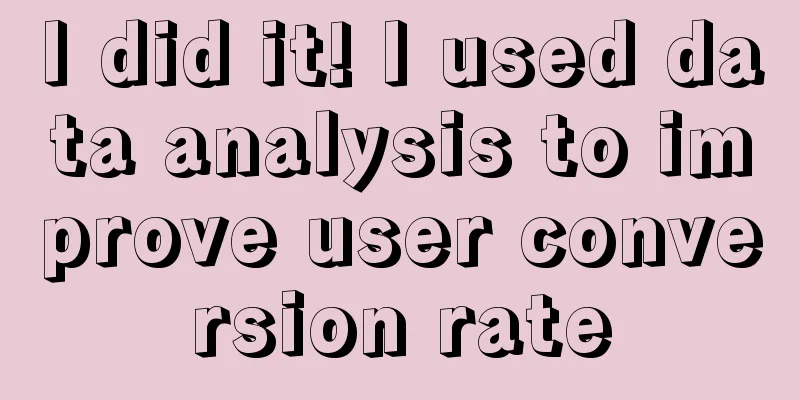I did it! I used data analysis to improve user conversion rate

"Data analysis must identify specific business optimization points" is the requirement of many companies for data analysts, and it is also a problem that makes many students headache. How do you draw an optimization conclusion from data indicators? Today, I will systematically explain how to do it based on a specific problem scenario. Problem scenario: An online education institution holds a free live broadcast every week, and all users can watch the live broadcast after making an appointment. The business side hopes to increase the user payment rate through live broadcast. But after a period of implementation, the business side began to wonder: Do the viewing rate and number of viewers after live broadcast registration have any effect on the payment rate? After all, live broadcasting also has costs. Why do I always feel that the conversion rate does not seem to increase after more broadcasts? ? Q: How to analyze this problem? Where are the optimization points for live broadcast business? 1. Common MistakesMany students are used to using whatever fields are in the database, without distinguishing the scenarios or labeling them, so naturally they can’t analyze anything. For example, in this case, it is very likely that the original data record is a live broadcast named XXX, with XX people signing up and XX people watching, and that’s it. Without thinking deeply, it is likely that you will tend to:
This way, we can calculate three numbers, but when we draw conclusions, we are easily challenged by the business:
This is where common doubts come from. The reason why these conclusions are nonsense is that after the business side has seen it, they really don’t know what to do. The optimization suggestions that the business side expects to hear are: Can live broadcasting still be done! If it can be done, how many shows should be done? What topics should be discussed? What links should be posted? If it can’t be done, how can I solve the sales problem! This is useful advice. So, how to solve the problem? 1. Understand the business scenarioTo find business optimization points, the first step is of course to return to the business itself. From the perspective of the education business itself: it is not a very appropriate behavior to have all users start live broadcasts in the same pot. This is because the needs of different users are completely different:
In short, different people have naturally different educational needs. When many students see this, they will instinctively say: The effect will be better if we conduct live broadcasts among different groups of people! You will also be criticized for this, because understanding the business scenario is just the beginning. 2. Analyze business pain pointsWhen making suggestions, avoid making suggestions that sound reasonable but are actually brainless: "The indicator is too low, we need to raise it" or "Mixed broadcasting is not good, we recommend separating them." Why? Because people are not fools. If they see that the indicators are low, they will definitely think about raising them. If they have the energy to do dispersed sessions, they will definitely think about doing them separately. There are usually hidden reasons behind practices that violate common sense . We need to further sort out and find the business pain points first. On the surface, the current problem is that the conversion effect brought by live streaming is not obvious. Looking deeper, the possible problem is: live broadcasts are all mixed together and there is a lack of classification guidance. Looking deeper, why is there a pot of stew? The hidden reason behind it is probably:
In short, the so-called splitting may only look good, but there are many practical complications. However, these specific pain points are a treasure for data analysis. The more specific the problem is, the easier it is to draw a conclusion; the more vague the problem is, the harder it is to draw a conclusion . With specific pain points, you can see how to use data to solve the problem. 3. Inductive analysis logicBusiness pain points may be scattered, and solving them with data requires analytical logic. The simplest way to build logic is to start from big to small, from rough to fine, first eliminate obvious problems, and then pursue details. In this case, from a data perspective, the above business pain points can be summarized into three categories of problems:
These three questions can directly lead to specific optimization suggestions. But please note that these three problems may be intertwined. For example, if a live broadcast fails to bring goods, it may be that the live broadcast itself is not good, or that users have no demand, or that the products do not match. At this time, it is necessary to construct analysis logic. Judging from the title, the business side did not dwell on users and products, but started with live broadcasting. Therefore, when constructing the analysis logic, we should also start with live broadcasting, and first eliminate the problem that the live broadcast itself is not well organized (as shown in the figure below). Secondly, in educational products, live broadcast topics are naturally related to the products to be sold, but not necessarily to the viewing users. Especially for novice users, they often cannot tell what they really want to learn and just watch it casually. Therefore, the second level can be divided into users, distinguishing between new registered users and old users (as shown in the figure below). Now that the analysis logic is built, you can fill in the data, but it is still recommended to do some preparatory work. 4. Prepare dataIn order to describe the business situation, it is often necessary to use a large number of labels, and it is very likely that these labels have not been prepared in advance. Therefore, preparation is required. For example, in this case:
These all need to be prepared one by one so that there will be clues for subsequent analysis. Note: It is very likely that the business side needs to analyze the conclusions urgently, and the previous infrastructure is very poor, so there is no time to label them one by one. At this time, you should remind the business side: without labeling, it is impossible to analyze the problem in depth. It is recommended to at least label some particularly important ones first, otherwise you will always cram at the last minute and never make progress. 5. Output analysis conclusionsWith all the above preparations, the last step is to fill in the data, which is a natural thing. Moreover, this kind of analysis can help you find the most obvious problem points and put forward very detailed optimization suggestions (as shown in the figure below. Note that due to space limitations, the figure below does not fully display the entire deduction logic. Interested students can complete it by themselves). When building the analysis logic, the situation corresponding to each type of user is actually a specific business optimization point, but the data is the final judge . The more situations occur, the more problems will be solved. Moreover, when two factors are intertwined, we can choose the main problem to solve based on the amount of data. This is exactly where data analysis is useful. Otherwise, there will be too many problems to solve. 2. SummaryTherefore, we need to go deep into the business scenarios, analyze the problems, and make arguments layer by layer to get better optimization points. Note: As optimization suggestions, they are generally proposed from the perspective of filling gaps, but filling existing shortcomings does not mean that it is the optimal solution. There may be better ideas. Author: Down-to-earth Teacher Chen Source public account: Down-to-earth Teacher Chen (ID: 773891) |
>>: These 27 types of content on Video Account will be restricted, so don’t post them anymore!
Recommend
How to set up Shopee promotional packages? What is the setting method?
I believe all Shopee merchants are aware that afte...
Quick Unlock in One Article: Price Analysis Model
In a highly competitive market, data-driven decisi...
How to run cross-selling ads on eBay? Is it effective?
On the eBay platform, cross-promotion ads are an e...
Is it reliable to transfer a Shopee store? Is it safe?
If the online store is not doing well, some mercha...
How did Amazon get started? How did it get started?
As the Amazon platform continues to grow, more and...
The Internet is full of "eye-catching" "AI photos"
From revealing AI beauties to suggestive AI handso...
Can Amazon sell virtual items? Is it easy to sell virtual items?
The profit margin of physical products is actually...
Practical application of the crowd reverse funnel model
In the wave of digital marketing, Xiaohongshu has ...
What is the golden rule for cross-border e-commerce product selection? Help you choose the best products
Choosing the right product among many products is ...
Do I need to fill in the tracking number for products shipped by Amazon?
For some small and medium-sized sellers, Taobao is...
How to join the Amazon platform? Process introduction
Among many cross-border e-commerce platforms, Amaz...
Behind Zheng Qinwen's gold medal at the Paris Olympics: some of the cooperating brands made a lot of money, while others fell silent
Zheng Qinwen won the women's singles tennis fi...
Does Amazon ship by air or sea? How does Amazon ship by sea?
In the field of cross-border e-commerce, logistics...
Vacancy breakthrough point, growth 3 focus
In the vast ocean of market competition, how can b...
With over 100 million views, internet celebrity "Gazhu Girl" is the new top streamer on Tik Tok!
Compared with the beautiful and exquisite beauties...






![Damn! I'm surrounded by the wool party [Part 2]](/upload/images/67e74c20c5c60.webp)


